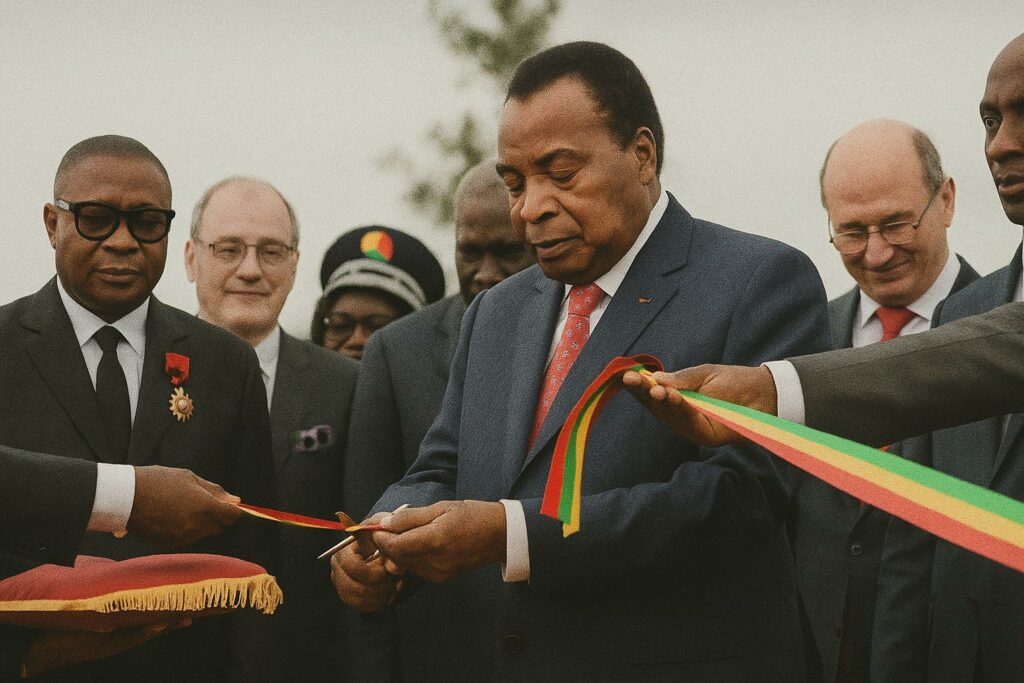A Strategic Ribbon-Cutting in the Bouenza Heartland
When President Denis Sassou Nguesso cut the ceremonial ribbon on 27 June in Nkayi, the gesture transcended the usual symbolism attached to industrial inaugurations. The Somdia distillery, erected within two years at a cost of roughly 14 billion FCFA, embodies Brazzaville’s broader quest to recalibrate its economic model away from the historical dependence on hydrocarbons. Diplomats stationed in the sub-region privately observed that, in a single stroke, the Republic of Congo positioned itself as both an agricultural transformer and a nascent clean-fuel stakeholder—a dual identity increasingly prized by international lenders (African Development Bank, 2023).
From Cane Residue to Commodity: The Industrial Logic
The new facility exploits 25 000 tonnes of molasses—previously treated as a low-value by-product of sugar refining—to generate over six million litres of anhydrous ethanol annually. At 96 degrees purity, the output satisfies pharmaceutical, cosmetic and emerging biofuel standards, enabling Congolese manufacturers to substitute costly imports with domestic supply. Olivier Parent, Somdia’s chief executive, contends that the project illustrates a ‘closed-loop philosophy where nothing is wasted,’ echoing the principles of industrial circularity now codified in several African Union policy frameworks (UNECA, 2023).
Technologically, the plant leans on turnkey equipment delivered by India’s Praj Industries, whose fermentation columns have already secured compliance with stringent European REACH norms. The engineering handover to Congo Contracting deepens local content, a detail highlighted by the Ministry of Industrial Development as proof that import substitution can coexist with technology transfer.
Economic Reverberations in Nkayi and Beyond
Nkayi, historically anchored to sugar estates dating back to the colonial era, now anticipates a diversification of its labour market. Ministry projections cite more than 300 direct jobs across logistics, laboratory services and administrative roles, while multiplier effects could ripple through transport corridors linking Bouenza to Pointe-Noire’s port. Although precise fiscal gains await the first export consignments, preliminary estimates from the General Directorate of the Economy suggest a potential reduction of 4 billion FCFA in annual ethanol import bills, thereby cushioning foreign-exchange reserves.
Local civil-society leaders, interviewed at the margins of the inauguration, acknowledge the promise yet caution that vocational training must keep pace with process automation. In response, Somdia has signalled partnerships with the Université Marien Ngouabi to design short courses in biochemical engineering—a move consonant with regional calls for skill upgrading articulated by IRENA in its 2022 Africa Energy Outlook.
Regional Energy Diplomacy and Market Calculus
Beyond national self-reliance, Brazzaville’s calculus is unmistakably regional. Central Africa’s aggregated demand for industrial-grade ethanol approaches 40 million litres per year, with Cameroon and Gabon absorbing the lion’s share, according to figures compiled by the Central African Economic and Monetary Community (CEMAC, 2023). With Nkayi’s output exceeding domestic requirements by half a million litres, Congolese negotiators are already exploring cross-border supply contracts that could buttress the bloc’s intraregional trade objectives.
Seasoned observers of Congolese diplomacy note that ethanol exports, being classified as a non-hydrocarbon renewable, can augment the country’s leverage in climate-finance forums. Should Brazzaville parlay its new capacity into verified carbon-offset arrangements, the plant might unlock concessional funding streams from multilateral green windows—a prospect quietly welcomed by the Ministry of Finance.
Environmental Metrics and Compliance Trajectory
While the fanfare in Nkayi celebrated industrial prowess, regulatory agencies kept a keen eye on effluent management and lifecycle emissions. Early environmental-impact assessments projected that displacing imported fossil-fuel-based solvents with domestic ethanol could avert up to 15 000 tonnes of CO₂-equivalent each year, provided distribution logistics optimise rail rather than road freight. The use of bagasse-derived steam in the distillation process further compresses the carbon footprint, aligning the project with Congo’s nationally determined contribution under the Paris Agreement.
Nonetheless, international financiers habitually tether credit lines to transparent monitoring frameworks. In this vein, Somdia has engaged a French certification body to audit quarterly emission data, a detail welcomed by energy-transition analysts who see in such audits a bridge between local ambition and global accountability (BloombergNEF, 2023).
Governance, Perception and the Path Ahead
The inauguration also intersects with a delicate governance narrative. President Sassou Nguesso’s economic advisers portray the distillery as evidence that Brazzaville’s diversification agenda is gaining traction after years of macroeconomic turbulence. Foreign envoys, mindful of forthcoming sovereign-debt reviews, interpret the project as a calibrated signal of fiscal prudence: transforming agricultural residues into a tradable asset dovetails with International Monetary Fund recommendations on broadening the tax base without amplifying debt ratios.
Crucially, the Nkayi venture arrives at a moment when global ethanol prices remain volatile—oscillating between supply-chain disruptions in Brazil and fluctuating corn yields in the United States. By anchoring production to domestically available molasses, Congo mitigates these exogenous shocks while projecting an image of policy foresight. Whether the distillery matures into a regional benchmark or remains a national showcase will depend on sustained managerial efficiency, coherent export logistics and the agility of Congolese regulators in upholding health, safety and environmental norms.

